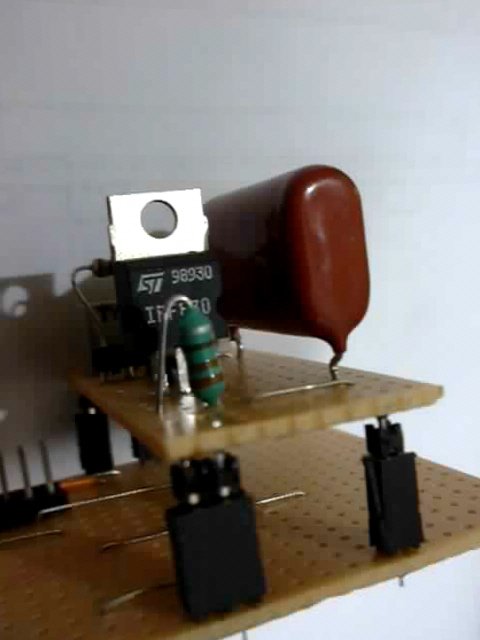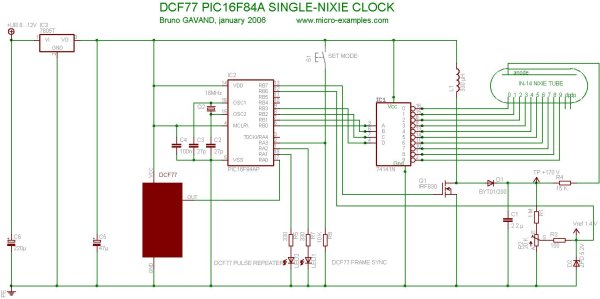- PIC16F84A microcontroller
- Single-digit Nixie, sequential hours, minutes and seconds display
- DCF-77 atomic clock, with automatic or manual time set-up
- high voltage power supply for Nixie with only 4 components
- 24 hours cycle programmable extinction time
- no MikroC compiler licence needed !
This project will show you how to drive a nixie tube display with a PIC16F84A simple microcontroller.
The nixie is a vertical-mount, front-reading IN-14 russian tube (thanks Alex !), very convenient for prototyping because of its long solderable pins.
How to power the nixie ?
 A 170 volt power supply must be applied between the anode of the tube and one of its cathod, to light the corresponding number from 0 to 9. The lightened number needs around 1.5 mA to glow.
A 170 volt power supply must be applied between the anode of the tube and one of its cathod, to light the corresponding number from 0 to 9. The lightened number needs around 1.5 mA to glow.If the voltage is lower, the number is not completely lightened and may even extinguish (under 140 V).
If the voltage is higher, digits will randomly light at the same time, and no digit will be clearly readable.
It is possible to get the high voltage from the main power supply, but it is highly dangerous because live parts may be exposed to dangerous voltage.
That’s why is use a DC/DC converter, which gives the +170V needed by the nixie from the +5V power supply of the circuit. The PIC16F84A generates a software PWM, and drives the MOSFET’s gate. The MOSFET switches on an off the current into a 300 µH coil. The inducted high voltage is collected by a fast recovery diode and then fed into a capacitor.
Note that the power supply is build as an individual board, I use it also in other test boards for other projects.
A simple resistor divider feeds back a voltage reference into a PIC input : if the voltage exceeds the 1 level of the PIC, the software turns PWM off, until the voltage turns under the 1 level of the PIC : then the PWM output starts again, and so on… this allows to keep a constant high voltage of around +170 V, depending on the variable resistor setting.
This is a close-up of the voltage reference divider.
We can also see that the 15 K anode current limiting resistor is mounted on a socket : during tests, a 47 K resistor was used. Remember this : reducing the current will increase the life of your tube ! You have to find a good value for a good brightness and a long life.
How to drive the nixie ?
The anode is connected to the high voltage through a 15 K resistor, in order to limit the current to approximately 1.5 mA. It is not possible to drive the cathodes with the pic output, because of the high voltage engaged.
I use a 74141 IC, which has been designed for nixie tubes : it includes a BCD to decimal decoder, and each output has a high-voltage transistor.

